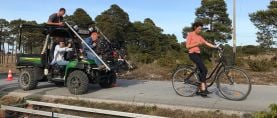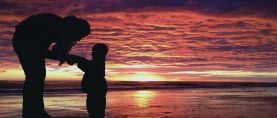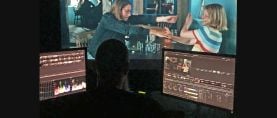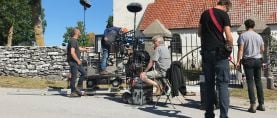
Bergman Island Journal — Part VI
The cinematographer’s updates on the making of this unique project set on Fårö, the Swedish island where Ingmar Bergman shot four features, lived, died and is buried.
Production images courtesy of the author
Editor’s note: This production diary will unfold over the following days in multiple parts (starting here), while a more formal interview with the cinematographer can be found here.
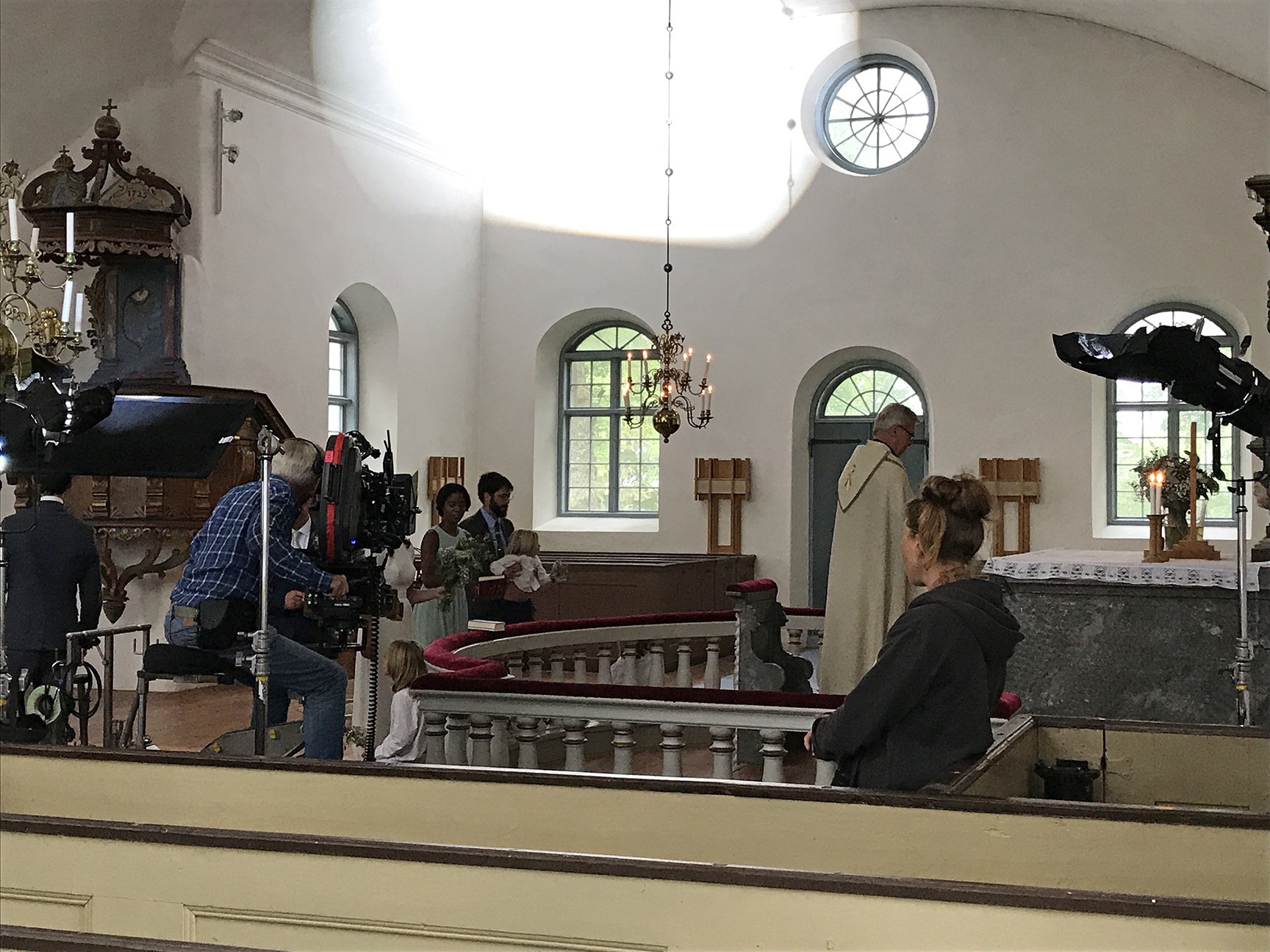
Week 3
Monday, August 20
Our whole day is in the Fårö Lutheran Church; no company move for once. As the weather is bad, I decide in the morning to go with the 5219 film stock, 500T instead of the 5207 250D I was imagining I would use. And no 85 filter, just an LLD; I rate my meters at 400 ISO. As you know by now, this is not a film where I can use one 18K per window — no money to rent them, no crew to use them, and no time to play with them — so instead I light from inside, using one Arri M18- 1.8 K, and two Jokerbug 800s with Bug-A-Beam adapters fixed 10-19-36°. I cannot imagine doing a movie without these two lamps, using a now well-known method I learned in 2010 or so from the gaffer on an HBO show where I didn’t last even a week before being fired for political reasons. At the time, using a Source Four to light from the opposite side of the room by bouncing it on the wall behind the actors just above the frame was a total epiphany. I’m still delighted when I can use that trick, and very grateful to whoever came up with that technique.
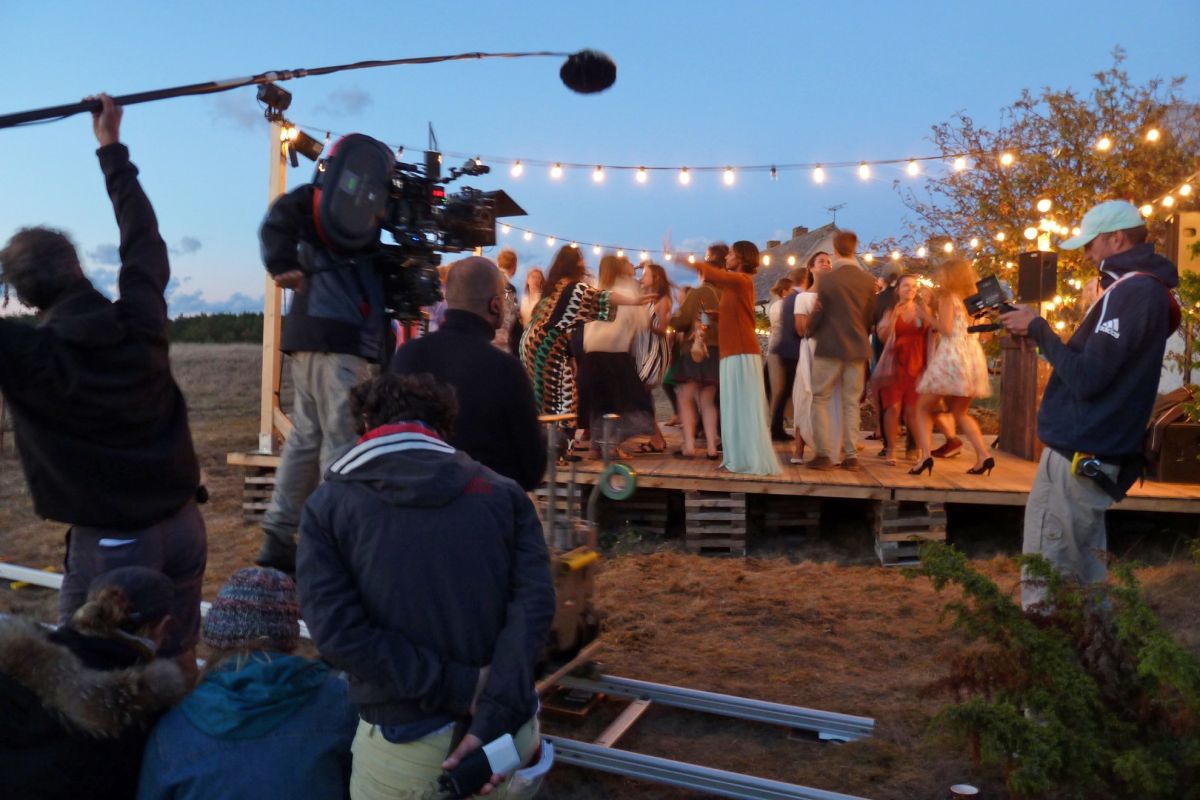
Tuesday, August 21
After the wedding ceremony in the church comes the outdoor wedding party. Blessed with wonderful sun, we film a late afternoon group photo; with the sun much lower, Amy wandering among the guests. And, finally, during the 45 minutes that magic hour exists here, a shot where Amy, lit by the glow coming from the dance floor, looks at the dancers. We move to the dancers, go back to her as she turns around and walks down a little path toward a fire and the silver lake.

Mikael and his team (with Dirk’s help) have done a splendid job with light ropes, candles, little braseros, and some lights inside the main house. I’m expecting this shot to be just gorgeous as it is the perfect late magic hour time. The sky is reflected in the lake; I can see very far away but it will be wonderfully dark. But I have to remember that almost every time I feel very happy with what I am filming I end up rather disappointed when I see the dailies, not that it is bad, only not as good as expected. The reverse is also true — sometimes I feel, as I’m filming, ashamed of my work, but when I see the dailies, it is not good at all but also not that awful. It’s as if there was on set some amplifying of my own judgment, in both directions.
Wednesday, August 22
We get two more shots in direct continuity with the final shot from last night. Easier to set up and install, but Mia has some small difficulties with an actor in the second one and I start getting worried when I see the light falling. Of course, Dirk is enhancing the fire effect, with a homemade panel of incandescent bulbs that he is dimming (4x4 frame with three lines of string lights for a total of 35 total sockets equipped with 40w bulbs wired through 3 dim channels, manually controlled on his iPad using Exalux Connect One). Even so, I guess the last two takes, the best ones, of course, are probably underexposed, but it will be all right. It would be easy to pour a little more light in the area we’re filming, but I learned through the years that, unless you’re spending a lot of time, way too much time, to do it properly, it is better to go underexposed than overlit. In short: Better not enough light than too much!
This is followed at the same location by a short scene with two actors, using our first circular track of the film and the lovely fire effect. And then we move to a satisfying transition shot, guests leaving the party as we track them back them to a bus. They are mostly backlit at the beginning, go even darker when walking along the bus and get proper light and exposure only when walking down the aisle inside the bus to their seat. And, finally, making Mia wait for half an hour because it was impossible to do ahead of time (the camera in the previous shot would have seen them), I have some lights rigged on the roof of the bus (2 x DMG/Rosco SL1 Switch and 2 x DMG/Rosco SL1 Mini Switch, all at 3000°K -20% and all fed by V-lock batteries), so when we film the actors in the bus, the sides of the road will not be pitch black when seen through the windows behind them (we’re in the country, not in a town that would have its own lighting).
Thursday, August 23
We do a retake of a bicycle shot (Mia the director wanted Mia the actress to look happier in the scene), followed by a brief dusk shot and a few night shots. Dirk is really a good gaffer (now that he’s finally getting some work on this show!). I describe to him what I wish for, he does it, and when I look at the final work there is almost never anything I want to change. It looks very natural; I always like it. Now the question: Do we happen to have the same taste, or has he very quickly understood what is my taste, even if his own is different? Has he studied my work?
Friday, August 24
First day, of many to come, in the minuscule Smurf house. Témoudjine is upstairs — in the tiny corridor and super small bedroom — using a Billet Bazooka by Ronford-Baker mounted on a 19” by 21” little platform, itself on a 16”-wide track. Not only is the space small, but the roof is very steep, only a third of the space is really usable. Oh well…
Fortunately the ground floor is a tad bigger, so we can use the JL Fisher 11. But I discover that it is too small, too weak, to raise me as it booms the camera up. Oh well again…
Week 4
Monday, August 27
Back in the little house for some day shots, lit and treated like those we shot on Friday, and some night shots. These are nights without practicals, the classical DP problem of a character wandering in the night with no lights on. And in this case, not even a lamp post giving some light through a window. Go dark, yes, go blue, possibly, but how to achieve something satisfying, always a question.
I go with soft light and, deciding to keep it consistent with the rest of the film, put gels on the windows — ND 1.2 + Full CTO + Pale Navy Blue 143 — instead of blacking them out. I use the same 143 on the tungsten sources inside the house. This is my color of choice for bluish nights, a gel the great Peter James, ASC, ACS introduced me to almost 30 years ago. I love how this blue is neither too garish and Hollywoodsy nor too green, but rather subdued and greyish.
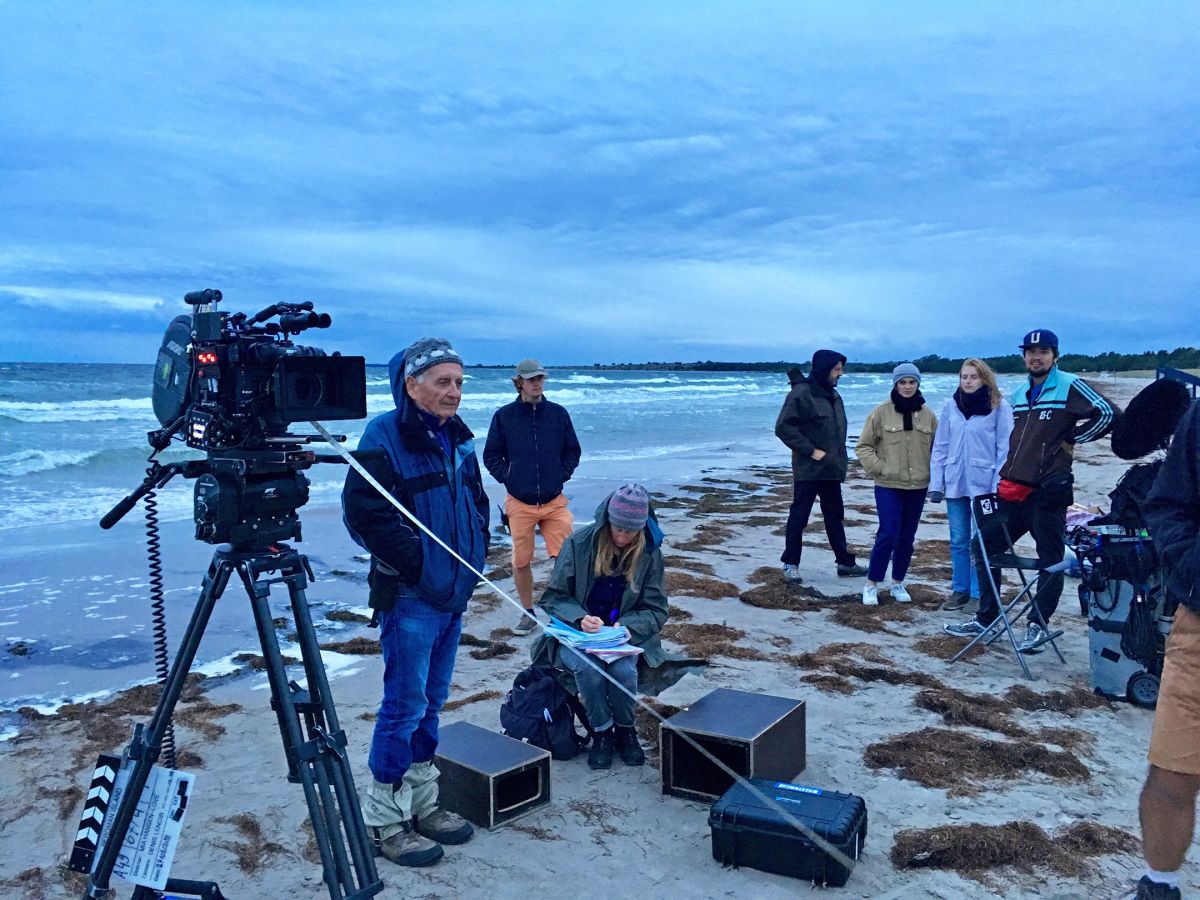
We end the day with some magic hour — here, dusk for dawn — of characters exiting a sauna and jumping into the sea. The sky is very dark because of the clouds and I’m a little short when filming; three stops under at 500 ASA, which is probably one too many. (Oh, I miss the Alexa!)
Tuesday, August 28
Tough day: we’re filming a love scene, which is never easy, in this crazy small house. It’s like working inside a car — grips and electrics cannot work at the same time, not enough room! We end the day inside the sauna. I asked Tobias several months ago about the maximum heat for the film stock and for the camera, and he was reassuring. He left on Saturday (his mother is having surgery; text today, all went well) and Olivier Servais is replacing him. I knew him from The Vintner’s Luck — very efficient and relaxed at the same time. Anyway, long story short, the film stocks and the camera are doing OK, but there is a problem with the video tap inside the camera, a good quality (but not reliable) HD one. We have to shut it down between takes and put some ice on it!
Wednesday, August 29
The love scene in the doll house is not finished, but now, after another timelapse, it is day. For me, it is the occasion to finally light through the window and get some backlight, and we are done, all extremely happy to leave this awful set. I share with Témoudjine first and later with Mia this idea I have — my DP colleagues are going to strangle me — that the location (or set) is everything. If it looks great (the church, the wedding party) and if you are not a stupid DP, it’s going to look fantastic. But if you’re filming in a gray box with no room to light and no depth behind the actors, even if you are Gordon Willis or Storaro, it’s going to look rather dull (particularly if you stick to the naturalistic codes).
Thursday, August 30
After a night in Visby (such an early call this morning), we spend the day in the Gotland ferry — six hours to Stockholm and back. It is the occasion to measure the kindness of the ferry employees and the placidity of the Swedish passengers. Only a few were in our way or looking at the camera, so we made the whole day very smoothly, and even faster than planned. Tobias and I will not have to come back and spend our Saturday filming second-unit shots in the boat’s car holding area, we manage even to film the two shots Mia wanted while the rest of the crew is wrapping the rest of the equipment. To get a high view of the cars, Tobias, helped by his height, manages to get on top of some kind of roof and films from there. I am on the ground with Mia, shouting instructions on the frame. Once more he is a very good sport.
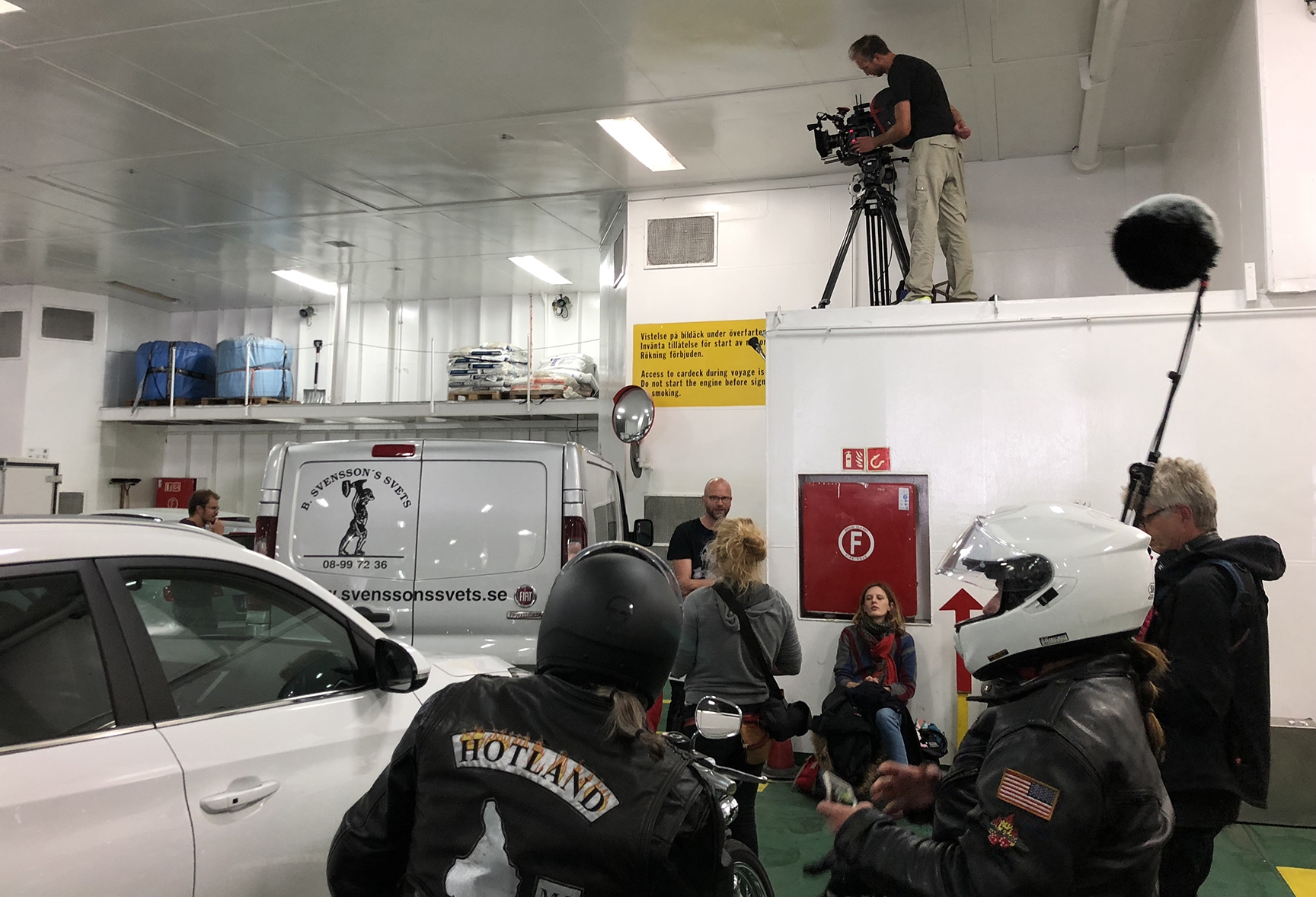
Friday, August 31
A few more shots in the ferry parking lot, this time with actors, and then a long day under pouring rain, inside a small car with four actors inside and Mia’s wish to have them all in the car the whole time so they can perform together. The only solution is to remove the front passenger seat, install the camera next to the gear handle and ask Albin (the Swedish actor supposedly seated there) to spend the scene on a small box (the famous French 15x20x30, all centimeters, which makes roughly 6x8x12 inches), crushed between the camera and the door. For one shot, a pan from Joseph to Amy, I need to be inside the car, so I give him a break and take his place.
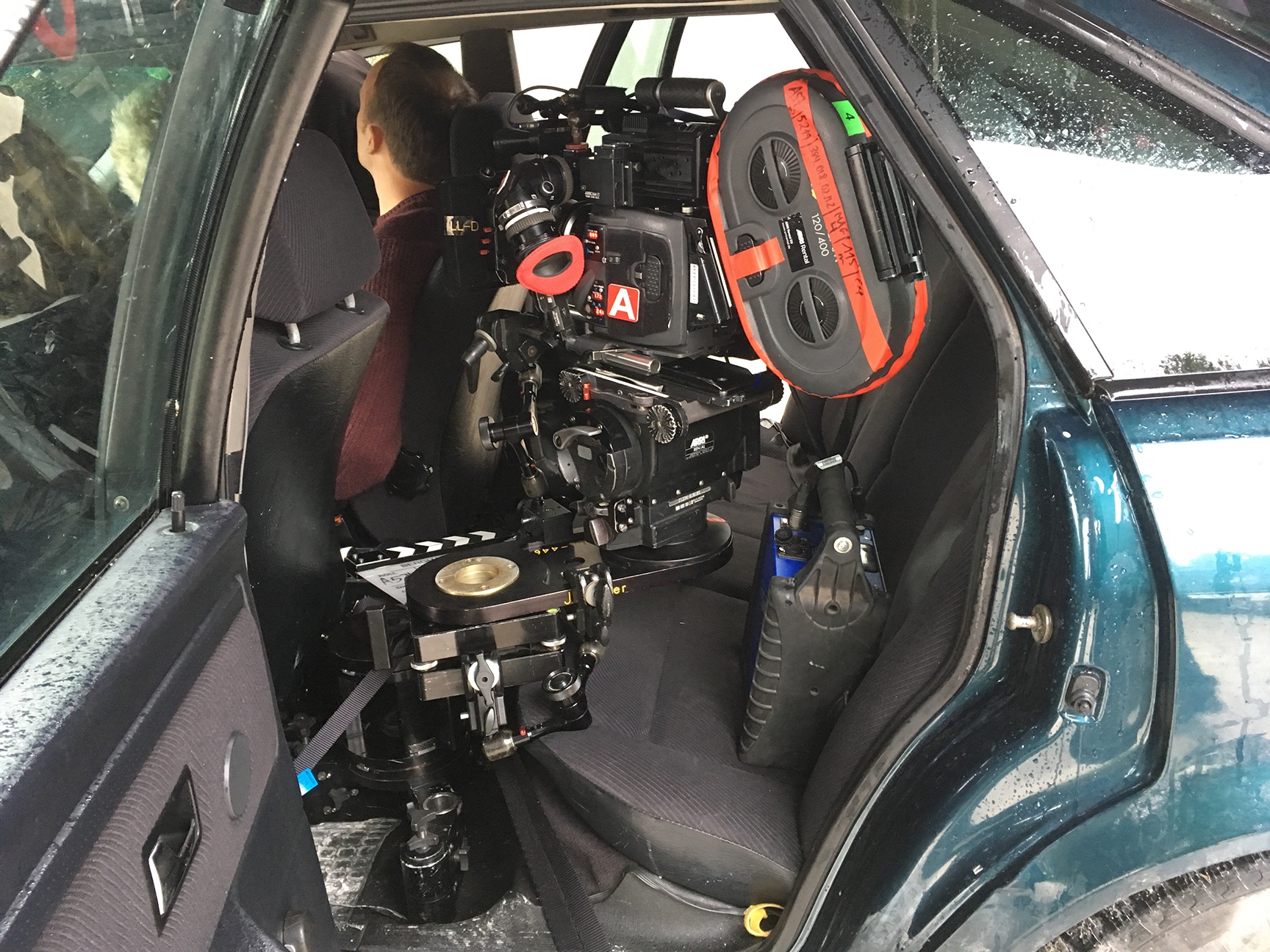
Saturday, September 1
Many thoughts as I am watching the dailies of the wedding party: it looks absolutely amazing, among my best shots ever, but what exactly am I responsible for in these shots? Shooting at dusk in a latitude where dusk is long enough to dare trying to shoot scenes at that time of day? Mia H-L; finding the exquisite location where it happens? Mia; designing the space, creating some parts where there will be lights and/or fires? Mia, with the help of Mikael; ordering and setting up these lights? Mikael, with the help of Dirk (and some input of mine, not to be overly humble); designing the shots? Mia. What I actually did: balancing the colors and the lighting values, executing the shots (with Témoudjine’s help); not negligible but not much to brag about.
To be continued in Part VII. Catch up with Part V here.
A more formal interview with the cinematographer can be found here.

